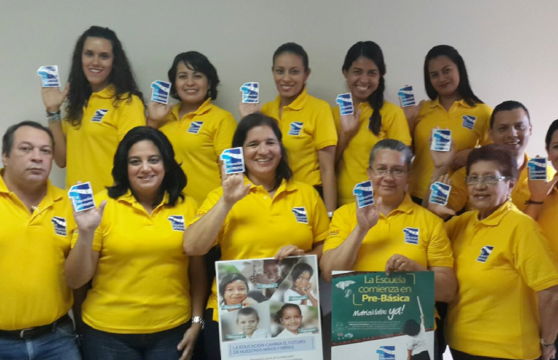
No Quality Education Without Quality Teachers
The dissemination of findings from a study on the state of teacher policies in Honduras has served to spark debate on how to improve teacher quality.
In 2015, Honduras’ economy continued to lag, placing second to last among the economies of Central America, followed only by El Salvador.[1] In Honduras, as in neighboring Guatemala and El Salvador, weak economic growth translates into scarce opportunities for the majority of its population. Faced with such limited economic prospects, many Hondurans opt to migrate by any means possible.
Economic Trends
Honduras’ economic model has not provided the fundamentals for sustainable economic growth and development. As of 2013, 59.4%[2] of the Honduran population lived below the total poverty line of 4 dollars a day. This is a trend that has not changed since 2004. Despite annual GDP growth of 4% on average, Hondurans have not seen substantive improvements in their lives as the GDP per capita has only grown at 2% a year, on average, over the past 15 years and inequality is pervasive.[3] Honduras is the most unequal country in Central America with 60% of people having annual incomes below US$2,000.[4]
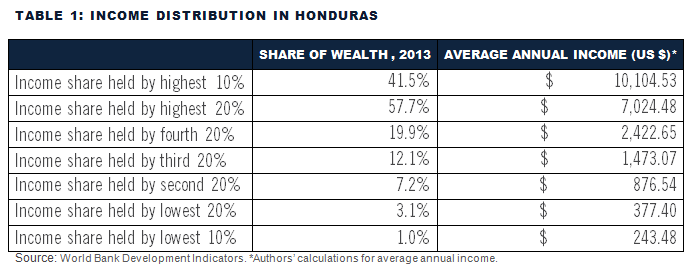
An increasingly complex security situation makes life difficult for Hondurans, and it is estimated that the annual costs of violence account for 9.6% of the country’s GDP.[5]
Honduras’ limited economic growth is a byproduct of an outdated economic model that presents few opportunities for sustainable and equitable development. In 2014, the economy was based on exports (34% of GDP), family remittances (17% of GDP), and tourism (4% of GDP). In fact, exports and migration represent more than half of the GDP of Honduras.[6]
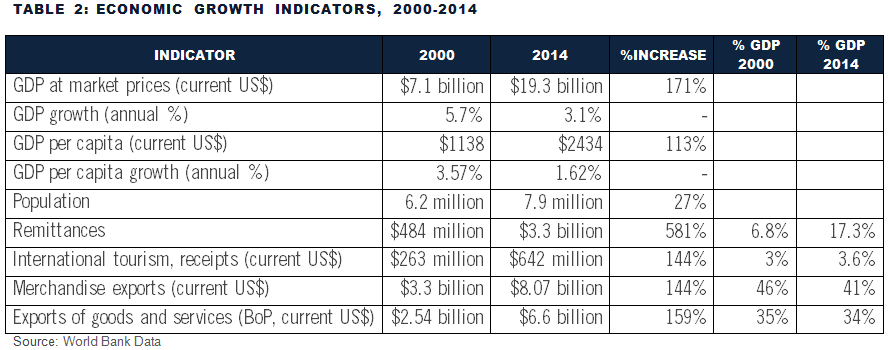
Honduras’ exports, which amount to roughly 40% of its GDP, are heavily concentrated in certain areas. Textiles and vegetables combined amount to the majority of all exports, and the United States is by far the largest trading partner.[7] According to United Nations trade data, Honduras has one of the lowest Export Diversification Indices in the world, falling 149th out of 217 participating countries.[8] Moreover, those who are linked to the export sector generally belong to the wealthiest families in the country, who benefit from the wide income gap (see table 1).
Jobs in Honduras, many of which are in agriculture and maquilas,[9] tend to be unskilled, underpaid and informal. In fact, less than half of the labor force works in the formal economy and at least 60% of businesses are informal enterprises, mostly single-person businesses that earn less than two minimum wages.[10] This informal sector contributes less than 25% of GDP, and often falls under conditions of underemployment. In fact, in past years the overall underemployment of the economically active population rose from 32.2 in 2008 to 60.5 in 2013, as the following graphic shows.[11]
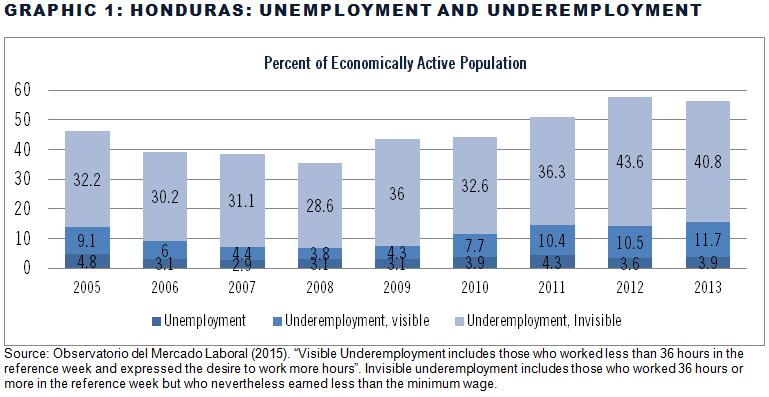
Attempting a New Strategic Approach: Zonas de Empleo y Desarrollo Economico (ZEDE)
In an effort to motivate economic development, the Honduran government passed a law in 2013 to create “free zones” (ZEDEs) in order to promote free trade and rule of law through private sector investments.[12]
Although ZEDE is sold by the government as “a 21st century, business-efficient, non-politicized, transparent, stable system of administration, plus a special police and institutional security to overcome regional issues and meet world standards,” there are concerns regarding its impacts.[13] So far, investors will be able to remove any family from their property if infrastructure is planned to be built in their way. As most of Honduras’ territories are inhabited by people who do not have titles for the land, there are concerns that poor people will be the most affected. Moreover, the approach, which is based around enclaves, does little to expand economic opportunities for the majority of the Honduran population.
In sum, Honduras faces a number of economic development challenges that have not yet been adequately addressed on a policy level. They have important implications for migration, human development, and social inclusion.
Implications for Migration
As a result of the high levels of poverty, violence, and inequality, as well as powerful pull factors from the United States, thousands of migrants continue to flee the country in search of a better future. Unfortunately, a sizable portion of this migration has been undocumented, with many Hondurans undertaking dangerous border crossings. In the most recent data from the U.S. Immigration and Customs Enforcement, Honduras ranked fourth in the countries with the most deportations (20,309) in the 2015 fiscal year.[14]

Implications for Development
Honduras’ economic model has been based on two primary sources of income, exports and migration, with a “missing middle,” the informal economy which contributes to 20% of GDP and includes the large majority of the labor force. Basically over 70% of the economy is connected to three sources of income.
With regards to the first source of income, the linkages between Honduras’ business sector and global markets are very weak. Only large and well-connected companies are able to bring their products to international markets, and the products that they do bring are concentrated to a handful of items. In undiversified markets, income is limited. For example, coffee exports in Honduras, estimated at US$1 billion, employ more than half a million people.[15]
With regards to the second source of income, migration is a dimension that continues to be overlooked by policy makers. Just in 2015, Honduras received $3.7 billion dollars in remittances.[16] In addition, Hondurans visit the country, call and text their families back home, purchase nostalgic goods and make philanthropic donations. Their participation in these economic activities is significant. For example, Hondurans spent approximately 382 million dollars in nostalgic trade exports, in addition to the money spent on calls.[17] Although these activities present important economic opportunities, the government continues to largely ignore them.
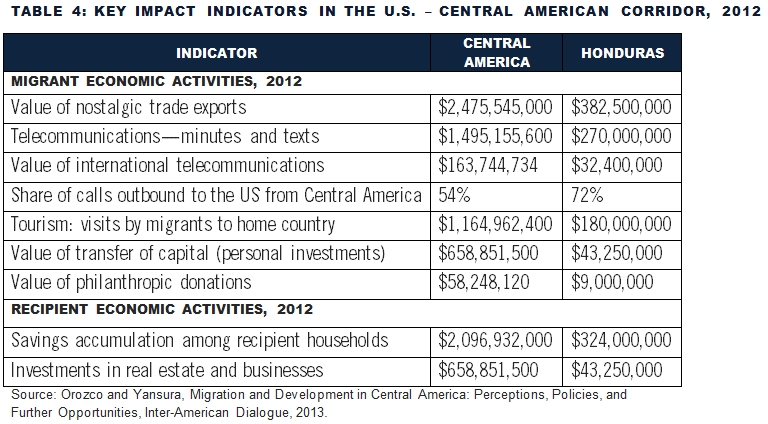
Towards A More Inclusive, Strategic Approach
Even though there have been attempts to update Honduras’ economic model, they have neglected a number of important dynamics. One of the major challenges of the Honduran government is to strengthen its citizens’ human capital. It does not matter if corporations are willing to come and invest in these “free cities.” Until there are enough educated and skilled citizens to fulfill the job requirements and to compete in the 21st century economy, the country’s economy will continue to be stagnant. Currently, the number of adolescents migrating is each year is higher than the annual enrollment in secondary school.
In order to reach higher levels of development, it is imperative that the government consider a new strategic approach that takes into consideration migration, social inclusion, and opportunities to build human capital.
An innovative development strategy integrating migration, remittances, savings and education can help Honduras attain greater levels of development and ensure that migration is a choice but not a necessity. The approach links migration and development through five unique and innovative components as suggested in our analysis[18] of the Alliance for Prosperity:
—————————————————————————————————————————————————————————————————————
[1] “Growth in Latin America Weakens for Fifth Year in a Row,” International Monetary Fund, 2015. https://www.imf.org/external/pubs/ft/survey/so/2015/CAR042915A.htm
[2] “Working to End Poverty in Latin America and the Caribbean Workers, Jobs, and Wages,” World Bank Group, (2015) https://openknowledge.worldbank.org/bitstream/handle/10986/22016/9781464806858.pdf?sequence=4
[3] Ibid
[4] Ibid
[5] Crime and Violence in Central America, A Development Challenge. World Bank. https://siteresources.worldbank.org/INTLAC/Resources/FINAL_VOLUME_I_ENGLISH_CrimeAndViolence.pdf
[6] World Bank Data
[7] Harvard Atlas of Economic Complexity, 2014 data. Available at: https://atlas.cid.harvard.edu/
[8] UNCTAD STAT. Available at: https://unctadstat.unctad.org
[9] According to a study by the Ministerio de Trabajo in 2008, agriculture is the largest single area of employment in Honduras, amounting for 34% of all jobs nationwide. It is followed by retail and non retail business, services, and manufacturing. For more information, see https://www.trabajo.gob.hn/organizacion/dgt-1/direccion-general-de-empleo/oml/Poblacion%20Economicamente%20Activa%20de%2035%20Anos%20y%20Mas%20en%20Honduras.pdf
[10] See the “Encuesta de Hogares 2004”. Instituto Nacional de Estadisticas. For additional discussion, see https://economiainformalhn.blogspot.com/
[11] Lefebvre, Stephan. Honduras: IMF Austerity, Macroeconomic Policy, and Foreign Investment. Center for Economic and Policy Research, Sep. 2015. https://cepr.net/documents/Honduras_IMF-2015-08.pdf. “Visible Underemployment includes those who worked less than 36 hours in the reference week and expressed the desire to work more hours. Invisible underemployment includes those who worked 36 hours or more in the reference week but who nevertheless earned less than the minimum wage.”
[12] For more information, see Rahn, Richard. Saving Honduras. CATO Institute, (2015) https://www.cato.org/publications/commentary/saving-honduras or Ley orgánica de las Zonas de Empleo y Desarrollo Económico (ZEDE) https://www.lamjol.info/index.php/LRD/article/viewFile/1768/1562
[13] Carasik, Lauren. There Are No Peasants Here. Foreign Policy, (2015) https://foreignpolicy.com/2015/10/23/there-are-no-peasants-here-honduras-zedes-land-grabs/
[14] ICE Enforcement and Removal Operations Report. Fiscal Year 2015. ICE, (2015) https://www.ice.gov/sites/default/files/documents/Report/2016/fy2015removalStats.pdf
[15] Carranza, Sara. Casi 20% de la población depende del café en Honduras. El Heraldo, 2015. https://www.elheraldo.hn/economia/837183-216/casi-20-de-la-poblaci%C3%B3n-depende-del-caf%C3%A9-en-honduras
[16] Manuel Orozco, Laura Porras and Julia Yansura, “The Continued Growth of Family Remittances to Latin America and the Caribbean in 2015, Inter-American Dialogue,” 2016.
[17] Manuel Orozco and Julia Yansura, Migration and Development in Central America: Perceptions, Policies, and Further Opportunities, Inter-American Dialogue, 2013.
[18] See https://www.thedialogue.org/blogs/2016/03/one-step-forward-for-central-america-the-plan-for-the-alliance-for-prosperity/
The dissemination of findings from a study on the state of teacher policies in Honduras has served to spark debate on how to improve teacher quality.
Central America is one of Taiwan’s only remaining diplomatic strongholds.
An op-ed on U.S. support for education in Central America.